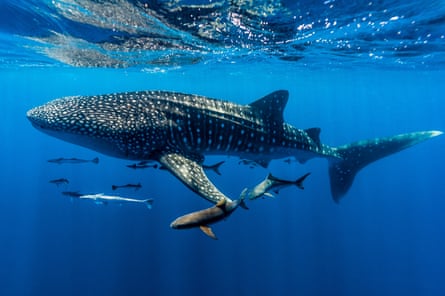The clutch of remora fish are holding on tight, but collectively release their grip just as the humpback whale they are riding breaches the surface of the ocean.
Moments later, everyone is back on board, as the whale re-enters the water, all hurtling together off the coast of south-east Queensland.
This rare footage of suckerfish was captured by marine scientist Dr Olaf Meynecke from Griffith University using camera tags attached to humpback whales.
“The remora are able to sense the change in speed and water depth,” he said.
“It was amazing to see how fast and nimble they were during several different rides with the whales.”
Remora are long, slender fish that grow between 30-90cm. Instead of a dorsal fin on their backs, remora have a suction disc that they use to attach to larger marine animals, earning them monikers like “sharksucker”, “whalesucker” or “marlinsucker”.
In Australia, there are several species of remora, known to attach to sharks, turtles, whales and dolphins, and occasionally even humans.
Little is known about them – they are challenging to study, due to their need for speed. But the footage offered fascinating insight, Meynecke said.
From the whale’s point of view, remora probably increased the total drag, he continued. In return, the hitchhikers likely earned their way by eating parasites and cleaning the whale’s skin.
The footage seemed to confirm this. Like humans, whales constantly shed dead skin, and in some vision, remora can be seen eating it.
Remora were generally thought to be host-specific, Meynecke said, which meant they remained with the same species all their lives.
But the sucker fish sometimes even attach themselves to scuba divers, Prof Culum Brown said, an expert in fish behaviour at Macquarie University, who was not involved in the research.
after newsletter promotion

Remora’s modified dorsal fin provided the suction and it is “quite a unique little engineering feat,” he said.
“If they’re pushing themselves up against their host and they wiggle backwards, it actually increases the suction. And if they swim forwards, it decreases the suction.”
By hitching a ride rather than swimming for themselves, remora gained several advantages, Brown said.
Aside from enjoying a feast of whale detritus, remora even breathe easier – instead of pumping water across their gills to breathe, they simply open their mouth and enjoy the ride.
“I think they’re basically cheating the whole system. They’re getting a free ride and a free feed, which is a bit cheeky,” Brown said.
Whale scientist Dr Vanessa Pirotta, who was not involved with the research, said whales were providing “the ultimate free Uber around the sea”. And remora weren’t the only animals hitching a ride, she said, but barnacles as well.
“Whales are a vehicle transporting an abundance of marine life throughout their journey. An aspect we often underestimate or simply don’t see,” Meynecke said.

 3 weeks ago
19
3 weeks ago
19

















































